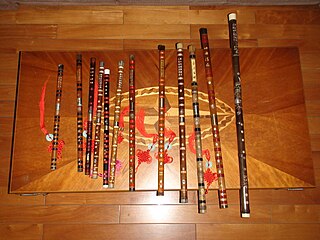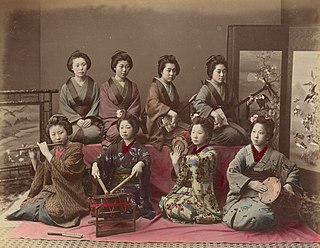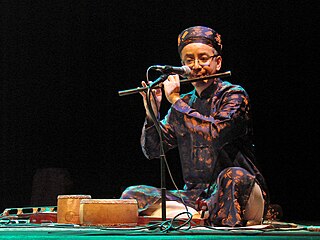![Bamboo clapper (w[?]:lk[?]khup[?]) Bamboo clapper Mallorca.jpg](http://upload.wikimedia.org/wikipedia/commons/thumb/e/e7/Bamboo_clapper_Mallorca.jpg/50px-Bamboo_clapper_Mallorca.jpg)
Bamboo clappers are a traditional Chinese percussion instrument and a traditional Burmese instrument. [1] Reflecting its name, it is made with boards of bamboo. Bamboo clappers are used in Chinese kuaiban storytelling performances. [2] [3]
![Bamboo clapper (w[?]:lk[?]khup[?]) Bamboo clapper Mallorca.jpg](http://upload.wikimedia.org/wikipedia/commons/thumb/e/e7/Bamboo_clapper_Mallorca.jpg/50px-Bamboo_clapper_Mallorca.jpg)
Bamboo clappers are a traditional Chinese percussion instrument and a traditional Burmese instrument. [1] Reflecting its name, it is made with boards of bamboo. Bamboo clappers are used in Chinese kuaiban storytelling performances. [2] [3]

The hyōshigi is a simple Japanese musical instrument, consisting of two pieces of hardwood or bamboo often connected by a thin ornamental rope. The clappers are played together or on the floor to create a cracking sound. Sometimes they are struck slowly at first, then faster and faster.

The dizi, is a Chinese transverse flute. It is also sometimes known as the di or héngdi, and has varieties including Qudi, Bangdi, and Xindi. It is a major Chinese musical instrument that is widely used in many genres of Chinese folk music, Chinese opera, as well as the modern Chinese orchestra. The dizi is also a popular instrument among the Chinese people as it is simple to make and easy to carry.

The bamboo flute, especially the bone flute, is one of the oldest musical instruments known. Examples of Paleolithic bone flutes have survived for more than 40,000 years, to be discovered by archaeologists. While the oldest flutes currently known were found in Europe, Asia too has a long history with the instrument that has continued into the present day. In China, a playable bone flute was discovered, about 9000 years old.

The pungi, originates from the Indian subcontinent. The instrument consists of a reservoir into which air is blown and then channelled into two reed pipes. It is played with no pauses, as the player employs circular breathing. In street performances, the pungi is used for snake charming.

The music of Myanmar shares many similarities with other musical styles in the region. Traditional music is melodic, having its own unique form of harmony, often composed with a 4
4 (na-yi-se), a 2
4 (wa-let-se) or a 8
16 time signature. In Burmese, music segments are combined into patterns, and then into verses, making it a multi-level hierarchical system. Various levels are manipulated to create a song. Harmony in Mahagita is known as twe-lone, which is similar to a chord in western music. For example, C is combined with F or G.

Mizoram is a region in India. Its folk music consists of vocals (singing) accompanied by traditional drums, gong and other native percussion instruments. There is also a long history of flute-playing which is now defunct. The drums are made from a hollow tree trunk with membrane made from cow hide and the gongs, made of brass, are very similar to those found in Myanmar.

A khloy is an ancient traditional bamboo flute from Cambodia and more specifically the Khmer people. The khloy and other similar bamboo flutes can be found throughout Asia, due to bamboo’s abundance in the region. The khloy is a duct flute and has two sizes: smaller, higher-pitched and larger, lower-pitched. It has six finger holes and a thumb hole, or seven finger holes and no thumb hole. A hole above the highest finger hole may be covered with a membrane made of rice paper or bamboo inner skin, similar to di mo.

The danso is a Korean notched, end-blown vertical bamboo flute used in Korean folk music. It is traditionally made of bamboo, but since the 20th century it has also been made of plastic. It was imported from China in the 19th century, where it is called duanxiao. The Korean name is the transliteration of the Chinese one, a short variant of the xiao.
There are many different dances of the Tripuri people, the largest ethnic group in the state of Tripura.

Tinikling is a traditional Philippine folk dance which originated during the Spanish colonial era. The dance involves at least two people beating, tapping, and sliding bamboo poles on the ground and against each other in coordination with one or more dancers who step over and in between the poles in a dance. It is traditionally danced to rondalla music, a sort of serenade played by an ensemble of stringed instruments which originated in Spain during the Middle Ages. The locomotor movements used in tinikling are hopping, jumping, and turning.

Traditional Japanese musical instruments, known as wagakki (和楽器) in Japanese, are musical instruments used in the traditional folk music of Japan. They comprise a range of string, wind, and percussion instruments.

A clapper is a basic form of percussion instrument. It consists of two long solid pieces that are struck together producing sound. A straightforward instrument to produce and play, they exist in many forms in many different cultures around the world. Clappers can take a number of forms and be made of a wide variety of material. Wood is most common, but metal and ivory have also been used. The plastic thundersticks that have recently come to be popular at sporting events can be considered a form of inflated plastic clapper.

The gourd mouth organ is a free reed mouth organ played across East and Southeast Asia. It consists of a gourd wind chest with several bamboo or bronze pipes inserted on top of it, the numbers of pipes differing from region to region.

The sáo is a family of flutes found in Vietnam that is traditionally thought to contain the culture and spirit of Vietnam's countryside. The most common variety is played with the flutist holding the sáo transversely to the right side with his or her mouth placed at the blowing hole. Other varieties include the Sáo Dọc, a kind of recorder similar to the Thai Khlui, the Sáo Bầu, and the Sáo ôi, a recorder played by the Muong people. The sáo is usually performed solo or in an ensemble among other instruments in orchestras of Vietnamese popular opera Chèo, Van singing genre, and Royal Small Orchestra.
Kuaibanshu is a form of oral storytelling performance that is popular in northern China. It is a type of shuochang, somewhat similar to Vietnamese vè or rapping.

The hsaing waing, commonly dubbed the Burmese traditional orchestra (မြန်မာ့ဆိုင်း), is a traditional Burmese folk musical ensemble that accompanies numerous forms of rituals, performances, and ceremonies in modern-day Myanmar (Burma).

The cảnh or tiu cảnh is a Vietnamese musical instrument. It is a form of small cymbal. It is part of the basic set of percussion instruments used for chầu văn alongside the phách bamboo clappers and the trống, a small two-headed barrel drum. These percussion instruments are placed on the floor and struck with wooden beaters.
Lebang Boomani dance is a harvest dance performed by the Tripuri people of Tripura, India. It is one of two dances associated with the Tripuris, the other being the Garia dance that is performed at the time of sowing crops.

The tube zither is a stringed musical instrument in which a tube functions both as an instrument's neck and its soundbox. As the neck, it holds strings taut and allows them to vibrate. As a soundbox or it modifies the sound and transfers it to the open air. The instruments are among the oldest of chordophones, being "a very early stage" in the development of chordophones, and predate some of the oldest chordophones, such as the Chinese Se, zithers built on a tube split in half. Most tube zithers are made of bamboo, played today in Madagascar, India, Southeast Asia and Taiwan. Tube zithers made from other materials have been found in Europe and the United States, made from materials such as cornstalks and cactus.